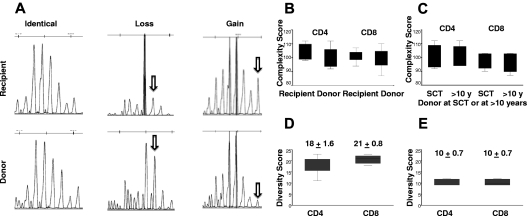Figure 4.
TCRVβ repertoire complexity and diversity scores in recipients and donors. (A) An example of pattern diversity between recipient and donor with both gains and losses of repertoire peaks in the recipient. (B) The TCRVβ diversity (total complexity score) as a measure of the polyclonality of the CD4+ or CD8+ T-cell repertoire. Overall complexity within a Vβ subfamily was determined by counting the number of discrete peaks for a Vβ subfamily, with each subfamily graded on a score of 0 to 5. There was no significant difference in total complexity score of CD4+ (P = .30) or CD8+ (P = .64) T cells between recipients and donors at SCT (6 pairs). (C) There was no significant difference in total complexity score of CD4+ (P = .54) or CD8+ (P = .25) T cells between donors at SCT and donors in the second decade after SCT (4 pairs). (D) There are significant different diversity patterns in TCR Vβ subfamilies between recipients and donors at SCT (6 pairs). The median diversity score for CD4+ and CD8+ T cells was 18 ± 1.6 and 21 ± 0.8, respectively. (E) The median diversity score for CD4+ and CD8+ T cells was 10 ± 0.7 for both CD4+ and CD8+ T cells, between donors at SCT and donors in the second decade after SCT (4 pairs).

